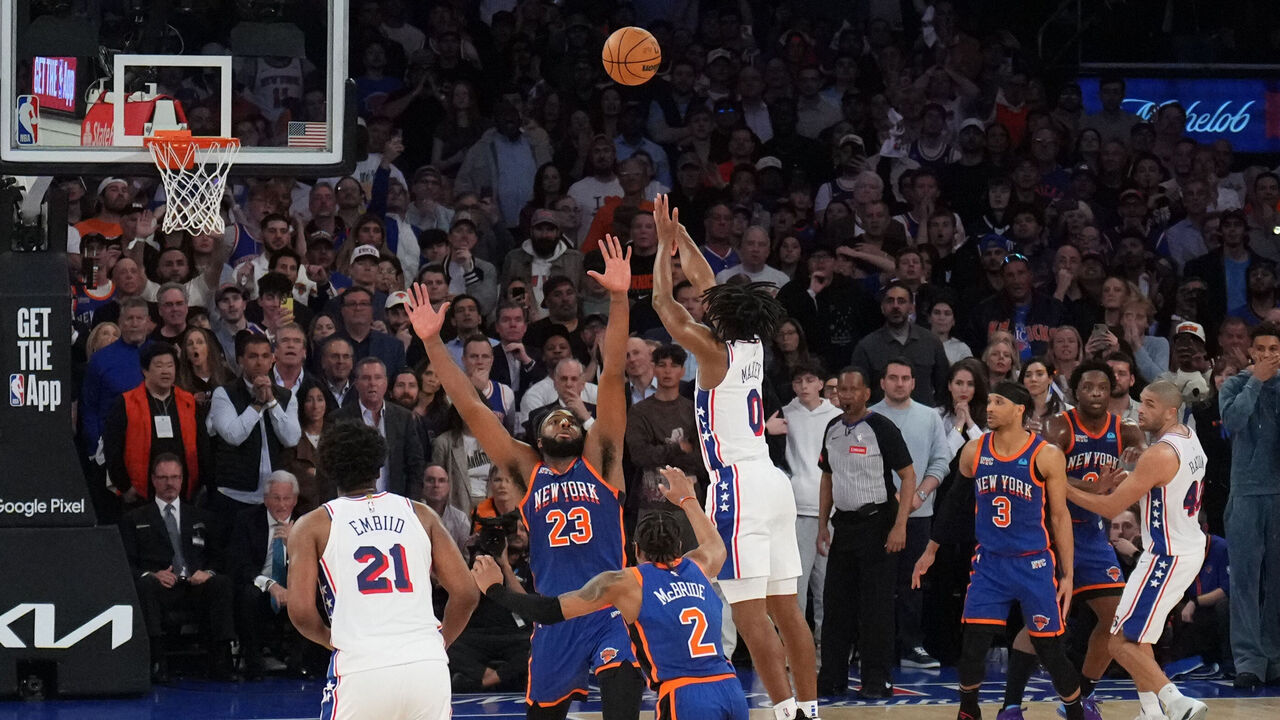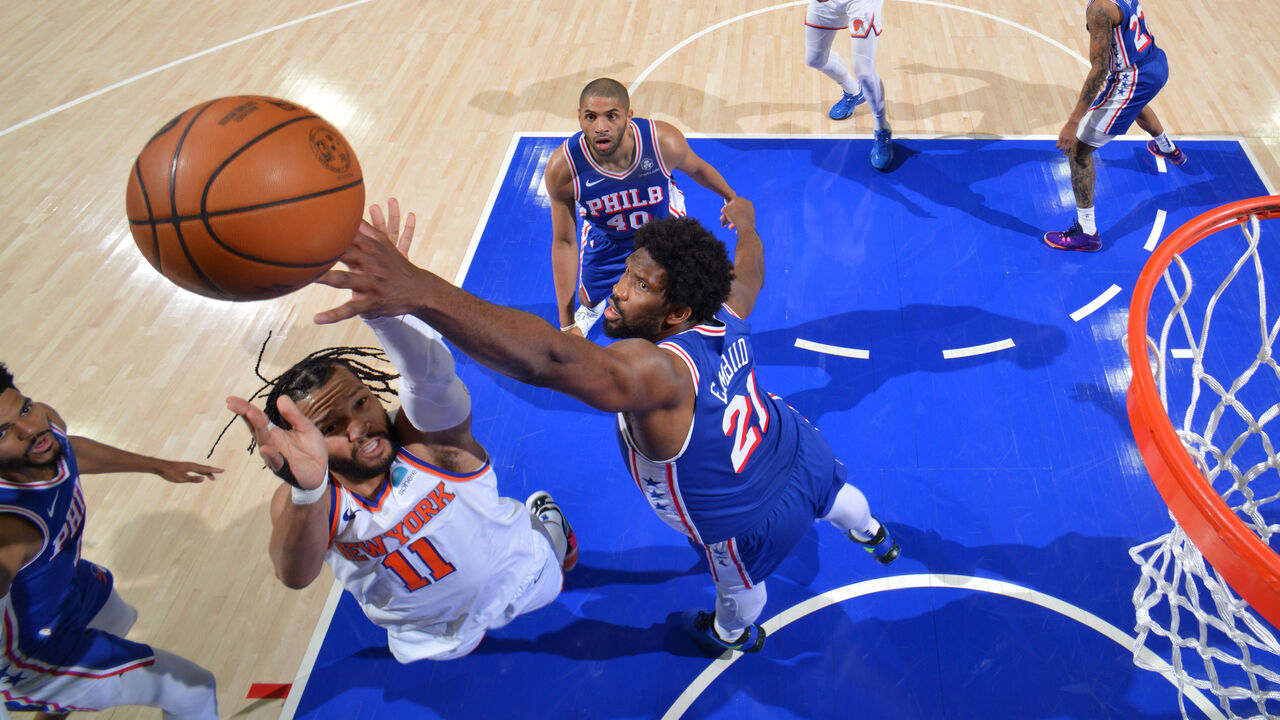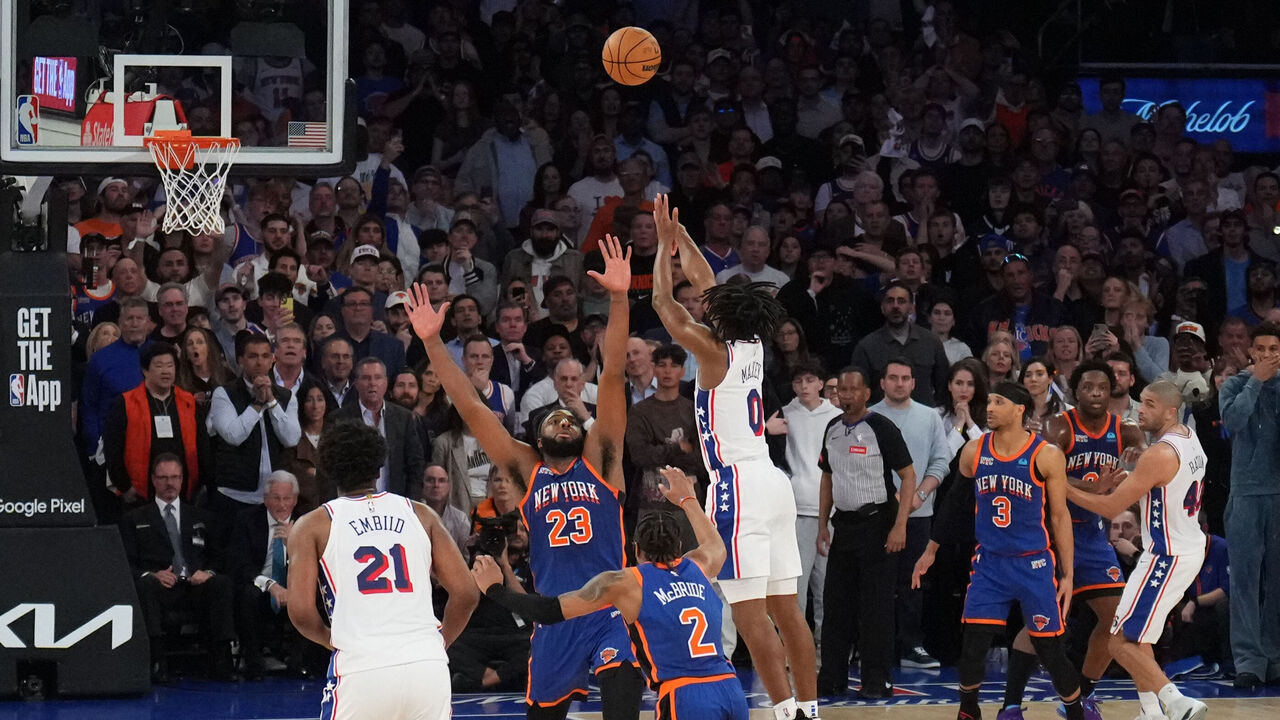Star turns, tactics make Knicks-Sixers absolute cinema
Five games in, the Eastern Conference quarterfinal between the New York Knicks and Philadelphia 76ers has been one of the most compelling, most delirious first-round series in recent memory.
Four of the five games were decided by seven points or fewer. Each team pulled off a miracle victory after trailing by at least five points with under 30 seconds to play. And we’ve seen legendary individual performances from the matchup’s biggest stars, with Joel Embiid pouring in a playoff career-high 50 points in Game 3, Jalen Brunson popping off for a Knicks franchise playoff-record 47 in Game 4, and Tyrese Maxey going for 46 – including seven in the final 25 seconds of regulation! – to engineer the second of those miracle comebacks and extend the Sixers’ season in Game 5.
Those three are the defining players of the series, but it’s everything going on around them – the ways their teams have helped unleash them and the ways each defense has tried to keep them under wraps – that’s made these games so fascinating. The series has featured fun tactical wrinkles and some stellar role-player performances, though the latter have mainly come from the Knicks’ side.
Embiid and Maxey were the best players in the series over the first two games in New York (when Brunson shot 29% from the field and 17% from deep) but the Sixers still came back to Philadelphia down 0-2 because their supporting cast was thoroughly outplayed. Since then, Brunson’s become increasingly comfortable, averaging 42 points and 9.7 assists in Games 3-5. But Embiid and Maxey have taken turns donning the superhero cape for the Sixers in those games, while Philly’s complementary players have worked to close the gap with New York’s. So back we go to Wells Fargo Center for Game 6.

In an uber-physical war of attrition, the Knicks’ role-player depth has shone through. Julius Randle never suited up, Bojan Bogdanovic went down midway through the series, Mitchell Robinson missed most of Game 3 and all of Game 4, and still this team’s threadbare rotation grinds on. Josh Hart, Isaiah Hartenstein, OG Anunoby, Donte DiVincenzo, Deuce McBride, and the odd cameo from Precious Achiuwa have all come through with vital contributions at various moments.
The Sixers have gotten very strong defensive work from Kyle Lowry, Kelly Oubre, and Nic Batum (the latter two have handled the Brunson assignment with aplomb). Still, Maxey and Embiid have gotten comparatively little in the way of supplemental offense. Their two-man game has been the lifeblood and also the bones, organs, and tissue of Philly’s offense.
Some of that discrepancy has to do with the teams’ contrasting defensive approaches. Though their help has gotten less aggressive as the series has gone on, the Sixers, in accordance with Nick Nurse’s M.O., have been more willing to let their shell get bent out of shape and to put themselves in rotation. They’ve shown Brunson plenty of traffic on his pick-and-rolls and drives, giving the rest of the Knicks some big gaps to attack.
The Knicks, by contrast and in accordance with their own coach’s philosophy, have mostly trusted their on-ball defenders to fight over or “ice” ball screens and handle the Maxey assignment without an abundance of gap help. That assignment primarily fell to Anunoby in the first three games, but Tom Thibodeau switched things up after that and gave the matchup to Hart (with a dash of DiVincenzo and McBride) in order to unleash Anunoby as a weak-side rim-protector who could roam off of Oubre or Tobias Harris. That worked out well in Game 4, when Maxey had his worst game of the series. Less so in Game 5.
Both star guards have spent the series trying to shed the long wing defenders dogging them and hunting for more favorable matchups. That often means hunting each other, though Brunson has also really enjoyed attacking Harris. The Sixers’ most successful actions are double drags that force Brunson to defend the first screen, which usually results in him switching onto Maxey and then trying to navigate the second one. But even when Brunson or one of their centers gets switched onto Maxey, the Knicks have been reluctant to commit extra defenders until he breaks the paint.
They’ve also played a lot of Embiid’s post-ups and face-ups in single coverage with either Hartenstein, Robinson, or versatile Anunoby, though that started to change after Embiid’s 50-burger. Down the stretch of Game 4 and for a big portion of Game 5, New York hard-doubled Embiid in the post, even when it meant helping off of Maxey from one pass away. The tactic seemed aimed at wearing down the reigning MVP, who was already compromised by a balky knee, partial facial paralysis, and migraines. It worked, in the sense that Embiid shot 7-for-19 with nine turnovers in Game 5. But that coverage also directly led to four of Maxey’s seven 3-pointers in the game, and helped Harris get going for the first time in the series.
In essence, the Knicks slowly ramped up their defensive aggression while the Sixers slowly scaled theirs back.
Early in the series, Philly was especially liberal helping off of Hart, parking his defender (usually Lowry) at the nail and sometimes having him intercept whichever Knicks center came up to set a ball screen, which allowed Embiid to stay out of the action and lurk near the basket in a one-man zone. When the Sixers double-teamed Brunson and zoned up the weak side behind the trap, they were comfortable either ignoring Hart entirely or offering a perfunctory stunt rather than a full rotation.
As such, three games into the series, Hart hoisted more wide-open threes than anyone in the playoffs and punished the defensive negligence by shooting 9-for-16 on them. When he wasn’t bombing threes, he was beating the nail help by zooming into the diagonal lane off the catch, driving for layups or kickouts or laydown passes. Or he was exploiting the inattention by crashing for offensive rebounds. (Despite standing 6-foot-4 in a matchup featuring three 7-footers, he’s the leading rebounder in the series, hauling in 12 boards a game.)
He did so much damage in those first three games that the Sixers decided to hew more closely to him off-ball and to dial up the pressure rather than laying back when the ball was in his hands. That adjustment resulted in Hart shooting 0-for-7 from the field and committing five second-half turnovers in Game 4. It also helped free up Brunson for his record-setting scoring outburst.

Hartenstein has also benefited greatly from the attention Brunson draws. The Knicks’ backup-turned-starting center is consistently able to slip into the soft underbelly of the Sixers’ tilted defense to hit high-arcing push shots and mash the offensive glass. He’s 10-for-14 from floater range in the series, the best conversion rate of any player with at least 10 attempts from that zone so far in the playoffs. But with Embiid mostly sitting in a deep drop when he screened, Hartenstein too found his offensive impact muted in Game 5. (Embiid was more willing to meet Brunson near the level when it was Robinson screening.)
The Sixers still found occasion to send waves of help at Brunson and even sprung the odd trap on him – McBride hit what appeared to be the series-clinching dagger after flashing to the nail underneath one such trap – but they were more committed to keeping his primary defender attached and keeping everyone else at home. Oubre and Batum were instrumental in making that work, and they’ve done a great job on Brunson all series, Batum in particular. The 35-year-old blocked Brunson on a drive to preserve the tie at the end of regulation, then forced a crucial turnover in overtime with a textbook side contest that forced Brunson to panic-pass out of a step-back 3-point attempt.
Brunson put together another monster game anyway, but he was visibly gassed by the end. And crucially, with the Sixers more attuned to putting bodies on his teammates, the Knicks were only able to grab six offensive rebounds after averaging 15 over the first four games. Embiid, despite barely being able to get off the ground and seemingly struggling with his vision and coordination, came up huge on that front. Give it up for the Rebound Rabbi.
There’s no telling what twists and turns this series will take from here, or who’ll be left standing when it’s over. Five players are averaging over 40 minutes a game. Hart sat for a total 13 minutes combined in five games. Embiid gutted through 47 ugly ones Tuesday and had enough left in the tank to dominate defensively in overtime.
This is real playoff hoops. Somehow it’s still only the first round. What a series. Bring on Game 6.


